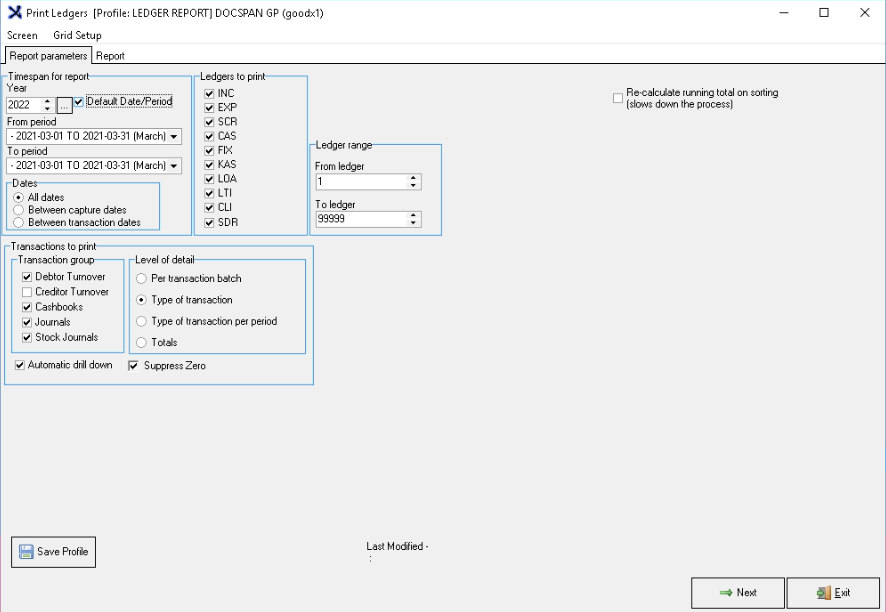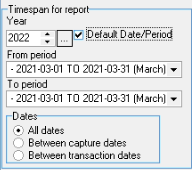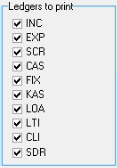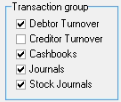Ledger Report: Settings and Parameters
This Manual will explain how and where to access and set up the Ledger Report Settings and Parameters.
All transactions must be posted to a ledger account in financial terms.
A Ledger account is a financial book (or record) for collecting historical transaction data from a journal and organizing entries by account.
Ledger account is summarized in types, for example:
- Income Ledgers.
- Expense Ledgers.
- Current and Fix Asset Ledgers.
- Liabilities Ledgers.
- Sundry Ledgers.
- Capital and Long-term ledgers.
The ledger report is a report of all the accounts of your business and is primarily used for monitoring the financial activity of your business. It details all business account and account activity during a period.
The ledger report contains the account summaries, including details of every transaction going in and out of your accounts. It is organized not only by date but also by account type.
The Ledger Report can be found under the Financial Reports Module.- The contents of this User Manual will consist of the following information:
- Report Parameters
- Date Settings
- Log In to the GoodX Desktop using your GoodX username and password.
- From the Navigator click on Financial Reports.

- The Financial Reports screen will open.

- On the Menu bar, click on the Ledgers menu.
- From the sub-menu select the Ledger Report option.
![]()
Current Profile: Print Ledgers
- The Current Profile: Print Ledgers screen will open.
- The BLANK and NONAME profiles will be loaded by default.

- Click on New to add a new profile to the list that can be customised to the needs of the practitioner.
- Click on Edit to make changes to an existing profile set up.
![]()
Take Note: When you set up a New profile or Edit an existing profile, the Report Parameters will open.
Report Parameters
- When Adding a new Profile or Editing an existing profile the parameters can be set up.
- The Print Ledgers Report Parameters Tab will open when clicking on the New or Edit button.

Date Settings
- Select the Timespan for Report.
Take Note: Tick the Default Date/Period block to default the report profile Setup to the current Financial Year and Period. The Report will always default to the current
Period and the Financial Year according to the computer date. The financial year is a period of twelve months used for tax or accounting purposes and for companies to determine and calculate their budgets, profits, and losses, for example, the South African tax year, runs from 1 March until 28/29 February of the following year unless specified that the client has their own financial year-end date.
- Select the Financial Year. The financial year is a period of twelve months used for tax or accounting purposes and for companies to determine and calculate their budgets, profits, and losses, for example, the South African tax year, runs from 1 March until 28/29 February of the following year unless specified that the client has their own financial year-end date.
- Select the Date (The From and To period. From the beginning when the system was used until the date in this section). The Ledger Report can be pulled for All dates (the financial period for which the report is drawn. The transactions that will be included in the report is for this specific financial period) or between dates.
- Select the Type of Dates.
- All dates - The financial period for which the Ledger Report is drawn. The transactions that will be included in the report is for this specific financial period.
- Between Capture dates - The date the transaction was captured on the system.
- Between Transaction dates - The date the service took place, the goods purchased, the patient treated or payment done or received.

- When the Between Capture dates OR Between Transaction dates options are ticked the following extra setting will display to put in the From and To date of the transactions.

Ledgers to Print
- All transactions must be posted to a ledger account in GoodX. A Ledger account is a financial book (or record) for collecting historical transaction data from a journal and organizing entries by account. Tick the ledgers that you want to print in the report.
- The Ledger accounts are summarized in types, for example:
- Income Ledgers - INC
- Expense Ledgers etc. - EXP

Take Note: for more information on the different Ledgers please click on the following link to open the Ledger Manager manual.
Transactions to Print
- Transaction group:

- Debtor Turnover: this will include the debtor invoices minus the debtor credit notes on the report.
- Creditor Turnover: this will include the creditor invoices (to whom money is owing) minus the creditor credit notes on the report.
- Cashbook: this option will include the transactions according to the cashbooks it was posted in. Cashbooks is a Financial journal that contains all the transactions for a specific type of receipt and payment. The entries will be posted to a general ledger.
- Journals: this will include all the journal transactions of the debtors (patients) on the report. The Journal function will allow the user to add or deduct amounts from the patient account and allocated them to an income or expenditure ledger account.
- Stock Journals: this will include all the stock journal (list and single adjustments) of the stock transactions on the report. Stock adjustments are done to adjust stock for a number of reasons, it could be for writing off stock, damaged stock or expired stock.
- Level of detail:

- Per transaction batch: this option will group the transactions types (turnover, cash flow etc) per batch number.
- Type of transaction: this option will group the transactions per type of transactions (invoice, credit note, receipt, payment).
- Type of transaction per period: this option will group the total per transaction type per financial period.
- Totals: this option will give the total per column per transaction grouping and no detail.
![]()
- Automatic drill down: this option will add an extra tab with the transactions and detail in the different groups.
- Suppress Zero: this option will hide all R0.00 balanced lines from the report.
Ledger Range
- Every ledger account is created with an abbreviation and a number, for example, INC 1. The ledger range is the range of the ledger accounts that you want to include in the 'Ledgers to print' report.

- Re-calculate running total on sorting: this option will re-calculate the columns running total when the columns sorting is changed. The running total will change when the transactions order change.
![]()
- Click on Save Profile to save all the settings that were set up in the Report parameters.
![]()
- Last Modified: the last modified field will display the User name (who made the changes), date and time stamp the Report settings and parameters that were changed or updated.
![]()
- Click on Next to continue to the Report.
![]()
- Click on Exit to close the Report Parameters screen.
![]()